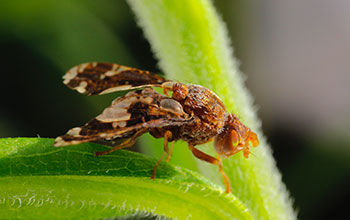Multimedia Gallery
Goldenrod can detect compound produced by gall-inducing flies
An international team of researchers has found that goldenrod can detect a compound produced by gall-inducing flies (Eurosta solidaginis).
More about this image
Tall goldenrod (Solidago altissima) is unable to physically move away from its enemy, the gall-inducing fly (Eurosta solidaginis), but an international team of researchers has found that it can still protect itself by first "smelling" its attacker and then initiating a defense.
In Pennsylvania, the flies feed only on tall goldenrod. Male flies emit a blend of chemicals that is attractive to females. Once the females arrive and the eggs are fertilized, the females deposit their eggs within the stem of a goldenrod plant. After the eggs hatch, the larvae begin feeding on the tissue inside the stem. Chemicals in the saliva of the larvae are thought to cause the plant to grow abnormally and form a gall, or protective casing of plant tissue, around the larvae.
"The flies strongly reduce the plant's fitness by decreasing the number of seeds it produces, as well as the sizes of those seeds," said John Tooker, an associate professor of entomology at The Pennsylvani State University (PennState). "That's because when the plant's tissues are damaged by the insect, it diverts its energy away from seed production and instead toward production of the gall."
Previous research by PennState researchers found that goldenrod plants exposed to chemicals from the male flies produced greater amounts of a defense chemical known as jasmonic acid when they were damaged by herbivores. For the current study, the team sought to identify the specific chemical compounds goldenrod plants are detecting, and to determine how sensitive the plants are to the compounds. They found that the plants responded most strongly to a compound called E,S-conophthorin.
"E,S-conophthorin is the most abundant compound emitted by the flies," said Anjel Helms, a postdoctoral fellow in entomology at PennState. "The compound appears to provide a strong and reliable cue for the plants to detect."
"We found that goldenrod plants are sensitive to even small concentrations of this compound," said Tooker. "This is significant because it likely means that the plant has a dedicated mechanism to perceive this compound. The results provide evidence that goldenrod can detect a single compound from the fly, supporting the idea that there is a tight co-evolutionary relationship between these two species. In other words, over time, as the fly has adapted to take advantage of the plant, the plant has adapted to protect itself from the fly."
This research was supported in part by the National Science Foundation.
To learn more, see the PennState news story Plant 'smells' insect foe, initiates defense. (Date image taken: May 2017; date originally posted to NSF Multimedia Gallery: May 29, 2018)
Credit: Nick Sloff/Penn State
See other images like this on your iPhone or iPad download NSF Science Zone on the Apple App Store.
Images and other media in the National Science Foundation Multimedia Gallery are available for use in print and electronic material by NSF employees, members of the media, university staff, teachers and the general public. All media in the gallery are intended for personal, educational and nonprofit/non-commercial use only.
Images credited to the National Science Foundation, a federal agency, are in the public domain. The images were created by employees of the United States Government as part of their official duties or prepared by contractors as "works for hire" for NSF. You may freely use NSF-credited images and, at your discretion, credit NSF with a "Courtesy: National Science Foundation" notation.
Additional information about general usage can be found in Conditions.
Also Available:
Download the high-resolution JPG version of the image. (1018.7 KB)
Use your mouse to right-click (Mac users may need to Ctrl-click) the link above and choose the option that will save the file or target to your computer.



